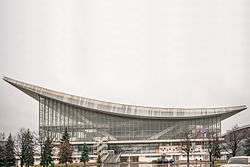Moscow Pavilion
The Moscow Pavilion (former expo67 Pavilion) was designed as an exhibition pavilion for the Soviet Union at the international exhibition Expo 67 in Montreal, Quebec, Canada. The project was designed by a team of architects led by Mikhail Posokhin. Since the 1990s, the pavilion it has been commonly called the Moscow Pavilion.

In 1970 this building served as the pavilion for Hungary as part of the Expo67 extension, Man and His World. As with many of the exhibition pavilions of several other participating nations, this glass & steel hall showcasing Russian industry & culture was always intended (and thus designed accordingly) to be dismantled at the conclusion of the year long 1967 international exposition in Montreal, Canada and returned to the USSR to be re-purposed as Airport Terminal. This was done quite easily as the Expo67 venue was purpose-built on an artificial island created directly south of downtown Montreal in the St.Lawrence River, A large crane was employed to lift the large modular wall and curved roof panels of the dismantled pavilion directly onto three Russian cargo ships moored in the adjacent river, which then carried it back to the USSR. For various reasons, the airport project was not realized and after sitting in storage for a decade, it was finally decided to reconstruct this spectacular building in Moscow, Russia at the Exhibition of the Achievements of the National Economy (VDNKh) at the northern entrance. The building plan was modified "vertically" in the course of reconstruction,adding three new floors to the base of the structure substantially raising its height, but not affecting the distinct curvature of the spectacular roof design. The rebuilt pavilion then received a new name: "Inter-industry Exhibition Pavilion", but in publications often it is called the Montreal pavilion. (It is interesting to note that in its reincarnation this beautiful building essentially serves the very same purpose for which it was originally conceived.)
The USSR Expo67 Pavilion is one of the finest examples of Soviet Modernism. The structure is built on a metal framework which is part of the internal and external structures, which play an architectural role. Directly in the entrance hall is on the high podium, which leads to the sweeping staircase. The facade of the pavilion is a continuous glass curtain wall with the expressive pattern of aluminum frames. Inside, the pavilion is divided into three floors, which are served by stairs and escalators that were taken from other buildings in Moscow.
External links
| Wikimedia Commons has media related to Pavillion No 70 Moscow (VDNKh). |
- Moscow Pavilion in the VDNKh website